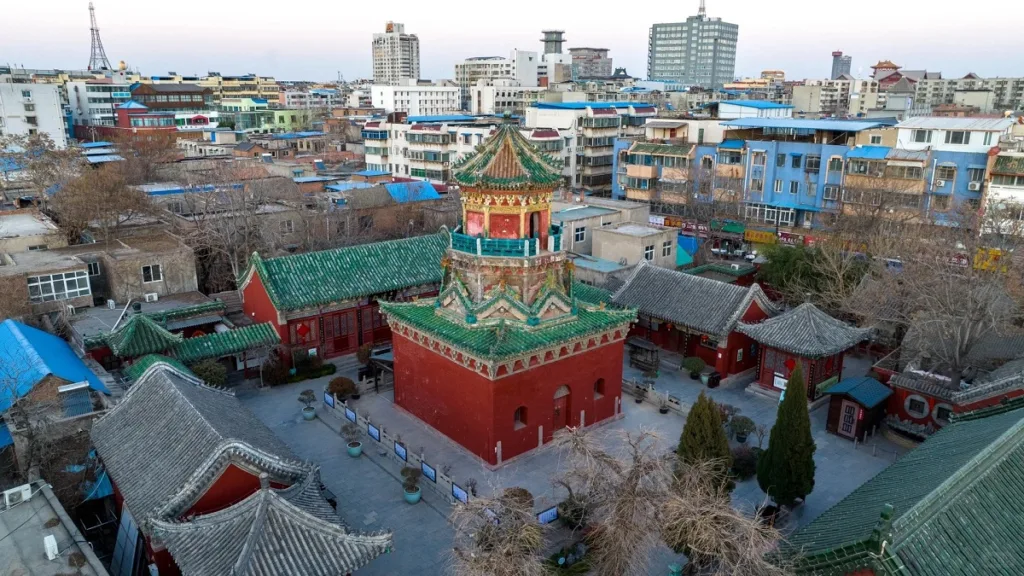Temple taoïste de Yanqing, Kaifeng - Billets, heures d'ouverture, emplacement et points forts


Yanqing Taoist Temple (延庆观), originally known as Chongyang Temple, was built in honor of the founder of Quanzhen Taoism, Wang Chongyang. Destroyed at the end of the Jin Dynasty, Chongyang Temple was rebuilt by followers of Quanzhen Taoism in the fifth year of the Yuan Dynasty’s Emperor Taizong (1233 AD), under the command of Qiu Chuji, a prominent figure in the Quanzhen tradition. This reconstruction effort spanned thirty years and resulted in a magnificent complex of grand halls, prompting the Emperor to grant it the name “Dachao Yuan Wanshou Palace.” However, the temple suffered destruction again towards the end of the Yuan Dynasty, leaving only the meditation hall standing.
In the first year of the Ming Dynasty’s Hongwu reign (1373 AD), the temple was renamed Yanqing Temple. One of its notable structures, the Jade Emperor Pavilion, originally part of the meditation hall, had its base submerged more than three meters underground due to repeated flooding. After excavation and restoration efforts, the pavilion was restored to its former glory. This three-story building now houses a bronze statue of Zhenwu (True Warrior), while inside the pavilion stands a Han white jade carving of the Jade Emperor, both regarded as precious cultural relics.
In recent years, new constructions such as the East and West Daoist Houses and the Sanqing Hall have been added to the temple grounds. Additionally, visitors can admire various exhibits including sculptures of Mongolian lion riders, depictions of the Eight Immortals drinking, as well as wood and brick carvings, all contributing to the rich cultural experience offered by Yanqing Taoist Temple.
Table des matières
- Informations de base
- Localisation et transport
- Highlights of Yanqing Taoist Temple
- Vlog about Yanqing Taoist Temple
- Attractions near Yanqing Taoist Temple
Informations de base
| Durée estimée de la visite | 1 - 2 heures |
| Prix du billet | 30 RMB |
| Heures d'ouverture | 8.00 – 18.30 (1th May – 31st October) 8.30 – 18.00 (1st November – 30th April) |
| Numéro de téléphone | 0086-0371-23931800 |
Localisation et transport
The Yanqing Taoist Temple is located in the northeastern part of Baogong Lake in Kaifeng City, Henan Province, China, at 53 Guanqian Street. To get there, you can take bus 1, 16, 19, 29, or L601 and get off at Yanqingguan Stop (延庆观站).
Highlights of Yanqing Taoist Temple
Jade Emperor Pavilion

The Jade Emperor Pavilion, also known as Tongming Pavilion, is a significant architectural structure within the Yanqing Taoist Temple, occupying approximately 76 square meters. Facing north to south, the pavilion stands tall at 18.25 meters and is divided into three levels: upper, middle, and lower. Constructed entirely of green bricks, green stones, and glazed roof tiles, it represents a unique blend of Han and Mongolian cultures with distinct characteristics of the Yuan Dynasty, forming a beamless pavilion typical of the Ming Dynasty.
The first level (lower level) of the Jade Emperor Pavilion is square-shaped, providing stability and symmetry with its four corners. Featuring a four-sloped roof, it is adorned with carvings of five mythical beasts symbolizing the hierarchical system: dragon, phoenix, lion, horse, and fish. The second level transitions into an octagonal shape, a rare architectural feature where a square shape abruptly transforms into an octagon. Surrounding the octagonal structure, continuous mountain patterns are formed using vibrant green glazed tiles, resembling towering mountain ranges. Each mountain peak is crowned with a dragon head facing inward, with an arrow handle inserted into the dragon’s back.
The third level takes the form of an octagonal pavilion, featuring a prominent plaque above the south-facing entrance, inscribed with the three characters “玉皇阁.” Inside the pavilion resides a precious Chinese artifact: a Han white marble carving of the Jade Emperor. Interestingly, there are no staircases between the second and third levels, emphasizing the divine status of the Jade Emperor, who transcends earthly matters. This design choice adds to the pavilion’s aura of mystery and inaccessibility, evoking a sense of awe and reverence towards the Jade Emperor.
Salle Sanqing

The Sanqing Hall stands as the holiest sanctuary within the Yanqing Taoist temple, occupying an area of approximately 53 square meters. Dedicated to the Three Pure Ones, this hall symbolizes the highest deities in Taoism. At the center sits Yuqing Yuan Shi Tianzun, the Primordial Celestial Worthy of the Jade Purity, holding the essence of all things like a blazing sun, representing the beginning of life and symbolizing children in the family. It is customary to offer prayers here when seeking blessings for children. To the left stands Taiqing Dao De Tianzun, the Celestial Worthy of the Great Purity, holding a gourd, symbolizing blessings and prosperity. This deity is revered for bestowing blessings upon the elders of the family, making it customary to offer prayers here for parents. On the right side is Shangqing Ling Bao Tianzun, the Celestial Worthy of the Highest Clarity, holding a ruyi scepter symbolizing fulfillment and auspiciousness in all endeavors, including work, marriage, and career.
Palais souterrain

Beneath the Jade Emperor Pavilion lies the Underground Palace, a unique and fascinating attraction within the temple complex. Covering an area of over 300 square meters, the Underground Palace features corridors, arcades, and a central area. Visitors can explore this underground marvel, walking along the Eight Trigrams pattern, and witness the historical transformation of the temple. Here, they can observe the unique process of lifting the entire historical structure of the Jade Emperor Pavilion from underground to above ground, providing insights into the temple’s rich history and architectural evolution.
Vlog about Yanqing Taoist Temple
Attractions near Yanqing Taoist Temple

Parc Bianjing

Kaifeng Fu

Lac Baogong

Salle des guildes de Shanxi, Shaanxi et Gansu

Tour de tambour de Kaifeng

Temple de Daxiangguo
Sites historiques du Henan, Attractions de Kaifeng